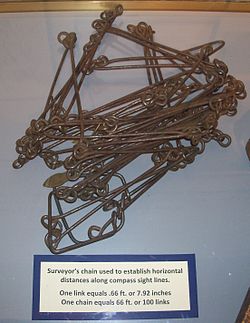- Gunter's chain
-
Gunter's chain is a measuring device used for land survey. It was designed and introduced in 1620 by English clergyman and mathematician Edmund Gunter (1581–1626) long before the development of the theodolite and other more sophisticated equipment, enabling plots of land to be accurately surveyed and plotted, for legal and commercial purposes.
A 1675 description states of the Gunter's Chain, "Dimensurator or Measuring Instrument whereof the mosts usual has been the Chain, and the common length for English Measures 4 Poles, as answering indifferently to the Englishs Mile and Acre, 10 such Chains in length making a Furlong, and 10 single square Chains an Acre, so that a square Mile contains 640 square Acres." ---John Ogilby, Britannia, 1675
Today in Britain, the Gunter Chain's most famous legacy is that it gave us the accurate length of the cricket pitch.[1]
Gunter divided the chain into 100 links, marked off into groups of 10 by brass rings which simplified intermediate measurement. On the face of it, the dimensions make no sense: Each link is 7.92 inches long; 10 links make slightly less than 6 feet 8 inches and a full length of 66 feet. In fact, he had made a brilliant synthesis of two incompatible systems, the traditional English land measurements, based on the number 4, and the newly introduced system of decimals based on the number 10.
"Gunter's chain allowed either method to be used. An acre measured 4,840 square yards in traditional units and 10 square chains in Gunter's system. Thus, if need be, the entire process of land measurement could be computed in decimalized chains and links, and then converted to acres by dividing the results by 10."[2]
Illustrations are available online.[3][4]
Richard Norwood used one in his 1633–1635 traverse of London to York (see his book A Sea-Man’s Practice).
The method of surveying a field or other parcel of land was to determine corners and other significant locations, and then to measure the distance between them, taking two points at a time. The surveyor is assisted by a chainman. A ranging rod (usually a prominently coloured wooden pole) is placed in the ground at the destination point. Starting at the originating point the chain is laid out towards the ranging rod, and the surveyor then directs the chainman to make the chain perfectly straight and pointing directly at the ranging rod. A pin is put in the ground at the forward end of the chain, and the chain is moved forward so that its hind end is at that point, and the chain is extended again towards the destination point. This process is called ranging, or in the US, chaining; it is repeated until the destination rod is reached, when the surveyor notes how many full lengths (chains) have been laid, and he can then directly read how many links (one-hundredth parts of the chain) are in the distance being measured.
The whole process is repeated for all the other pairs of points required, and it is a simple matter to make a scale diagram of the plot of land. The process is surprisingly accurate and requires only very low technology. Surveying with a chain is simple if the land is level and continuous—it is not physically practicable to range across large depressions or significant waterways, for example. The triangulation method requires that the land is plane (not varying significantly in slope). On sloping land, the chain was to be "leveled" by raising one end as needed, so that undulations did not increase the apparent length of the side or the area of the tract.[5]
The theodolite, developed later, enables accurate assessment of angles, and surveying points over long distances became possible. The Gunter's chain was still in use for small surveys in the second half of the twentieth century. In the US, Public Lands Survey plats are still published in the Chain unit to maintain the consistency of a two-hundred-year-old database.
The chain as a unit of length of 66 feet (20.1168 m) and the link, one-hundredth of a chain, probably developed as a result of the introduction of Gunter's chain as the technique of surveying; but it is important not to confuse the two; Gunter's chain is the physical device used in the field. A chain also has the commonly used subunit variously called a "rod", a "pole" or a "perch", which was 16.5 feet long, or one fourth of a chain (5.0292 m).[6]
References
- ^ Australian Popular Culture, By Ian Craven, Martin Gray, Geraldine Stoneham, British Australian Studies Association. Published 1994, Cambridge University Press Popular culture ISBN 0-521-46667-9. Page 27.
- ^ Linklater, Andro, "Measuring America", [Penguin, 2003] pp.16–17
- ^ Image from 1675
- ^ Nineteenth century image
- ^ [1] Holloway, Thomas, "The practical surveyor. Horace Cox:London, 1881. pp.22–24. Retrieved April 7, 2009
- ^ [2] Nesbit, Anthony, "A complete treatise on practical land-surveying, Ninth edition." London: Longman, Brown, Green and Longmans, 1847, p. 29. Retrieved April 7, 2009.
External links
Categories:- Surveying instruments
- Units of length
- Imperial units
- Customary units in the United States
Wikimedia Foundation. 2010.

